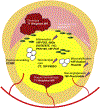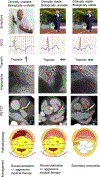New methods to image unstable atherosclerotic plaques
- PMID: 29602139
- PMCID: PMC6463488
- DOI: 10.1016/j.atherosclerosis.2018.03.021
New methods to image unstable atherosclerotic plaques
Abstract
Atherosclerotic plaque rupture is the primary mechanism responsible for myocardial infarction and stroke, the top two killers worldwide. Despite being potentially fatal, the ubiquitous prevalence of atherosclerosis amongst the middle aged and elderly renders individual events relatively rare. This makes the accurate prediction of MI and stroke challenging. Advances in imaging techniques now allow detailed assessments of plaque morphology and disease activity. Both CT and MR can identify certain unstable plaque characteristics thought to be associated with an increased risk of rupture and events. PET imaging allows the activity of distinct pathological processes associated with atherosclerosis to be measured, differentiating patients with inactive and active disease states. Hybrid integration of PET with CT or MR now allows for an accurate assessment of not only plaque burden and morphology but plaque biology too. In this review, we discuss how these advanced imaging techniques hold promise in redefining our understanding of stable and unstable coronary artery disease beyond symptomatic status, and how they may refine patient risk-prediction and the rationing of expensive novel therapies.
Keywords: Computed tomography; Positron emission tomography; Unstable plaque.
Copyright © 2018 The Authors. Published by Elsevier B.V. All rights reserved.
Conflict of interest statement
Conflicts of interest
The authors declared they do not have anything to disclose regarding conflict of interest with respect to this manuscript.
Figures






References
-
- Falk E, Pathogenesis of atherosclerosis, J. Am. Coll. Cardiol 47 (8 Suppl) (2006. April 18) C7–C12. - PubMed
-
- Schaar JA, Muller IE, Falk E, Virmani R, Fuster V, Serruys PW, et al., Terminology for High-risk and Vulnerable Coronary Artery Plaques Report of a Meeting on the Vulnerable Plaque, June 17 and 18, 2003, Santorini, Greece, 2004, pp. 1077–1082. - PubMed
-
- Jones CB, Sane DC, Herrington DM, Matrix metalloproteinases: a review of their structure and role in acute coronary syndrome, Cardiovasc. Res 59 (4) (2003. October 1) 812–823. - PubMed
Publication types
MeSH terms
Substances
Grants and funding
LinkOut - more resources
Full Text Sources
Other Literature Sources
Medical

